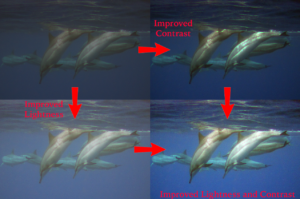Your cart is currently empty!
Light-hearted Contrasting Opinions

So just what is lightness and contrast?
In an image, lightness (or brightness) is the overall light level. The picture of an eel in a coral crevasse at 30 feet is a good example of an image without much lightness, unless you illuminate it with a strobe. A dolphin just under the surface can be an example of an image with high lightness.
But wait a minute…that dolphin may be nicely illuminated by the rays of the sun entering the water just a few feet above, but the odds are that the picture you took is not very close. The light bouncing off the dolphin and into your camera is filtered and lessened by the water in between. So that dolphin image may not have much lightness, even though the mammal is nicely lit. A better example of high lightness is a coral fan close to the surface, motionless or nearly so, allowing you to get close so that your camera can soak up all that light.
Related, but slightly different, is contrast. A good way to imagine contrast is as the difference between the brightest and darkest portion of the image. For that coral, it’s the brightest part, probably near the top (hopefully not bleached) where the angle reflects the sun best toward you, and the darkest shadow, lower down where the sun does not hit at the moment you clicked the shutter button.
In most images, the range of contrast is not optimum. In some images, like a snapshot of a friend in the bright sun with the dark forest in the background, there will be too much contrast. In others, and particularly in underwater images, there will be too little due to factors like low illumination and light scattering by the water.
Additionally, both lightness and contrast are constantly changing as you move, your subject moves, a cloud comes by, you point your camera differently…the list goes on and on. This is just a small portion of the reasons that video correction is very difficult. But for still images, a moment frozen in time, you can adjust lightness and contrast relatively easily.
In general, lightness and contrast, although adjusted separately, affect the image in similar ways, so going back and forth between the two provides the best results. One reason that you will often want to tweak these controls is that automatic analysis of the image does not know what the subject is. But you do, so you can make the important part of the image look its best.
